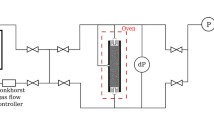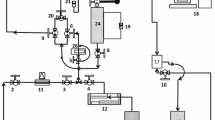Abstract
Foam flow experiments were carried out to study the influence factors such as surfactant concentration, foam quality, injection rate of liquid and gas, permeability of porous media, temperature, and oil saturation on blocking ability and flowing characteristics of steady foams in porous media. Foam blocking mechanisms and flowing characteristics were summarized according to the experimental results and foam migration behavior. The results showed that the pressure distribution of flowing foams was linearly descending in porous media at steady state. The results further showed that the foam size and quality in pores along the sand pack were almost uniform, that is, foam generation and destruction gradually reached dynamic equilibrium at steady state. In porous media, the blocking ability of steady foams increased with the concentration of the foaming agent and the increase in the permeability of porous media, but the blocking ability decreased with the increase in the temperature, the shearing rate, and the oil saturation of the porous media. Foam resistance factor reached maximal value at the foam quality of 85% in porous media.
Similar content being viewed by others
Abbreviations
- CMC:
-
Critical micelle concentration of surfactant in solution, wt%
- AOS:
-
Alpha olefin sulfonate, which is a kind of surfactant
- BS-12:
-
Dodecyl dimethyl betaine, which is a kind of surfactant
- SDS:
-
Sodium dodecyl sulfate, which is a kind of surfactant
- V fm :
-
Foaming volume of foaming agent, ml
- T 1/2 :
-
Half-life of foams, min
- p fm :
-
Inlet pressure of sand pack for injection foam at steady state, kPa
- p wg :
-
Inlet pressure of sand pack for injection water and gas at steady state, kPa
- p out :
-
Outlet pressure of sand pack, kPa
- p sc :
-
Standard pressure, P sc = 101.325 kPa
- Δp fm :
-
Working pressure drop of injection foam across the sand pack, Δp fm = p fm −p out, kPa
- Δp wg :
-
Basic pressure drop of injection water and gas across the sand pack, Δp wg = p wg −p out, kPa
- R fm :
-
Foam resistance factor, \({R_{\rm fm} =\frac{\Delta p_{\rm fm}}{\Delta p_{\rm wg}}}\), dimensionless
- Q L :
-
Injection liquid flux at standard conditions, ml/min
- Q g :
-
Injection gas flux at standard conditions, ml/min
- R gL :
-
The volume ratio between gas and liquid at the inlet of sand pack at inlet pressure, dimensionless
- Q fm :
-
Foam flux at the inlet of sand pack at inlet pressure, ml/min
- x fm :
-
Foam quality at the inlet of sand pack at inlet pressure, dimensionless
References
Chen M., Yortsos Y.C., Rossen W.R.: Insights on foam generation in porous media from pore-network studies. Colloids Surf. A 256(2–3), 181–189 (2005)
Chou, S.I.: Conditions for generating foam in porous media. SPE 22628, SPE 66th Annual Technical Conference and Exhibition, Dallas, TX, Oct. 6–9 (1991)
Cox S.J., Neethling S., Rossen W.R., Schleifenbaum W., Schmidt-Wellenburg P., Cilliers J.J.: A theory of the effective yield stress of foam in porous media: the motion of a soap film traversing a three-dimensional pore. Colloids Surf. A 245(1–3), 143–151 (2004)
Ettinger, R.A., Radke, C.J.: Influence of texture on steady foam flow in berea sandstone. SPE 19688, SPE Reserv. Eng. 7(1), 83–90 (1992)
Friedmann F., Chen W.H., Chen W.H., Chen W.H.: Experimental and simulation study of high-temperature foam displacement in porous media. Soc. Pet. Eng. J. 6(1), 37–45 (1991)
Gauglitz P.A., Friedmann F., Kam S.I., Rossen W.R.: Foam generation in homogeneous porous media. Chem. Eng. Sci. 57(19), 4037–4052 (2002)
Karin M., Idar S.: Effect of oil saturation on foam propagation in snorre reservoir core. J. Pet. Sci. Eng. 23(3–4), 189–200 (1999)
Karin M., Idar S.: Surfactant concentration for foam formation and propagation in snorre reservoir core. J. Pet. Sci. Eng. 30(2), 105–119 (2001)
Kovscek A.R., Bertin H.J.: Foam mobility in heterogeneous porous media. Transp. Porous Meida 52(1), 37–49 (2003)
Kuhlman, M.I., Falls, A.H., Hara, S.K., Monger-McClure, T.G., Borchardt, J.K.: CO2 foam with surfactants used below their critical micelle concentrations. SPE 20192, SPE Reserv. Eng. 7(4), 445–452 (1992)
Lee, H.O., Heller, J.P.: Laboratory measurements of CO2 foam mobility. SPE 17363, SPE Reserv. Eng. 5(2), 193–197 (1990)
Lee, H.O., Heller, J.P., Hoefer, A.M.W.: Change in apparent viscosity of CO2 foam with rock permeability. SPE 20194, SPE Reserv, Eng. 6(4), 421–428 (1991)
Mahmud W.M., Nguyen V.H.: Effects of snap-off in imbibition in porous media with different spatial correlations. Transp. Porous Media 64(3), 279–300 (2006)
Mannhardt, K., Novosad, J.J., Schramm, L.L.: Comparative evaluation of foam stability to oil. SPE 60686, SPE Reserv. Eval. Eng. 3(1), 23–34 (2000)
Martine G., Didier L., Denis B.: A film-flow model to describe free water transport during drying of a hygroscopic capillary porous meidum. Transp. Porous Media 48(2), 125–158 (2002)
Maurdev G., Saint-Jalmes A., Langevin D.: Bubble motion measurements during foam drainage and coarsening. J Colloid Interface Sci 300(2), 735–743 (2006)
Neethling S.J., Lee H.T., Grassia P.: The growth, drainage and breakdown of foams. Colloids Surf. A 263(1–3), 184–196 (2005)
Pacelli L.J.: Foam drainage in porous media. Transp. Porous Media 52(1), 1–16 (2003)
Pacelli L.J., Quoc P.N., Peter K.C., Marten A.B.: Coupling of foam drainage and viscous fingering in porous media revealed by X-ray computed tomography. Transp. Porous Media 64(3), 301–313 (2006)
Rossen W.R.: A critical review of roof snap-off as a mechanism of steady-state foam generation in homogeneous porous media. Colloids Surf. A 225(1–3), 1–24 (2003)
Schramm L.L., Novosad J.J.: The Destabilization of Foams for Improved Oil Recovery by Crude Oils: effect of the nature of the oil. J. Pet. Sci. Eng. 7(1–2), 77–90 (1992)
Siddiqui S., Talabani S., Yang J., Saleh S.T., Islam M.R.: An experimental investigation of the diversion characteristics of foam in berea sandstone cores of contrasting permeabilites. J. Pet. Sci. Eng. 37(1–2), 51–67 (2003)
Tisne P., Doubliez L., Aloui F.: Determination of the slip layer thickness for a wet foam flow. Colloids Surf. A 246(1–3), 21–29 (2004)
Wang Z., Ganesan N.: Model for plateau border drainage of power-law fluid with mobile interface and its application to foam drainage. J. Colloid Interface Sci. 300(1), 327–337 (2006)
Xu Q., Rossen W.R.: Effective viscosity of foam in periodically constricted tubes. Colloids Surf. A 216(1–3), 175–194 (2003)
Author information
Authors and Affiliations
Corresponding author
Rights and permissions
About this article
Cite this article
Pang, ZX. The Blocking Ability and Flowing Characteristics of Steady Foams in Porous Media. Transp Porous Med 85, 299–316 (2010). https://doi.org/10.1007/s11242-010-9563-2
Received:
Accepted:
Published:
Issue Date:
DOI: https://doi.org/10.1007/s11242-010-9563-2




